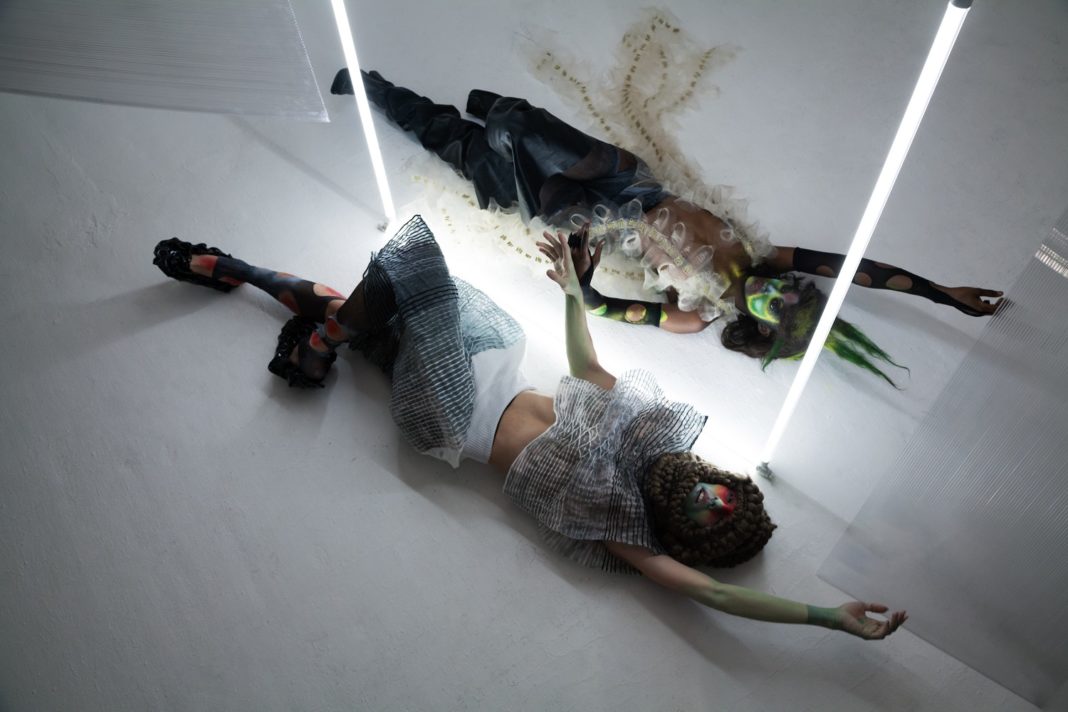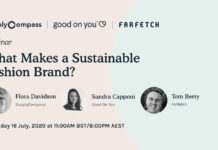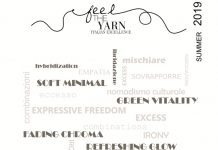Held annually at the Business Design Centre in Angel, London, New Designers showcases the next generation of graduate designers from universities across the UK. With over 3000 graduates displaying their collections across two weeks, the show provides an opportunity for design graduates to introduce themselves to industry.
Describing themselves as a platform for discourse and debate, New Designers gives a chance for discovery of new talent, and dialogue between industry and the aspiring students who hope to join it. Many students present fresh approaches to solving industry problems, whilst others showcase their unique approaches to their discipline, pushing their craft into new spheres of creativity.
Often challenging to display in static environments, textiles can lose their impact when constrained to the walls of a gallery space. Impressively, the following seven knitters managed to stand out from the crowd, offering enticing approaches to knitwear design.
Linxi Zhu: UAL – London College of Fashion, BA Knitted Textiles
Graduating from LCF, Linxi Zhu’s approach to knitted textiles is an unconventional one. Inspired by irregularities in X-ray images, Linxi makes knitted fabrics and garments without employing any traditional pattern cutting techniques. Fascinated by the challenge of making pattern pieces without cutting fabric or fashioning knitted panels, Linxi makes her garments from simple shapes. Using post machine processes, she manipulates simple squares and circles into complex 3D forms.
Utilising Dubied machines and Stoll knitted pieces within her collection, Linxi also added many mixed media processes including smocking, pleating and embellishment using up cycled materials such as paperclips.
Embarking on her MA in Fashion Design at the Royal College of Art in September, Linxi is excited to push her work in new exploratory projects. Having focussed primarily on fabric creation during her BA, the MA will challenge her to engineer her fabrics into garment form. It will certainly be interesting to see where her different approach to garment creation takes her during her further study of fashion design.
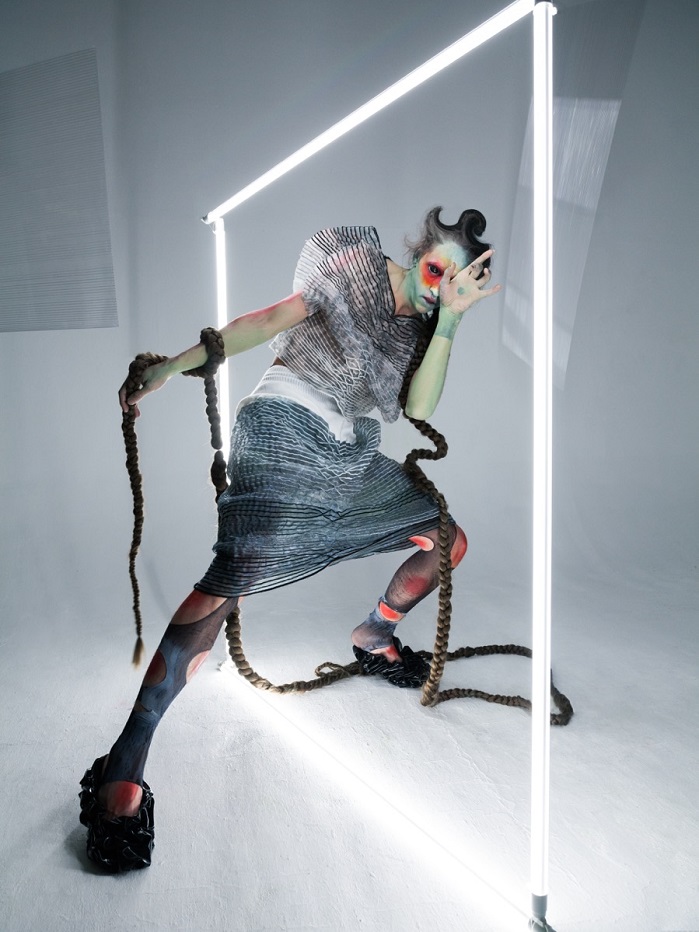
Elsie So: The Glasgow School of Art, BA Textile Design
Within her graduate collection Quotidian Sensibility, Elsie explored a range of knit techniques, processes and machinery. The project stemmed from socio-cultural research of the everyday, investigating quotidian tasks such as the packaging of items.
Integrating channels within knitted structures and weaving in cords post machine, whilst also exploring intarsia structures and multi-carrier techniques, Elsie’s fabrics are both striking and captivating. Part of the beauty held within Elsie’s work is her clear aptitude for flat-bed knitting. Her flat-bed samples sit alongside the Stoll pieces indistinguishably, with exquisite attention to detail.
Elsie shared an insight into the brilliant opportunity she had the pleasure of undertaking with TextielLab in The Netherlands.
“The project was partly developed at TextielLab – a specialist workshop based in Tilburg, the Netherlands. As part of their student programme I was selected to develop some samples with their expert knit developers. Through this collaborative experience, I was able to tap into digitalised knitting facilities, while furthering technical explorations and design sensibility within my graduate project,” Elsie said.
Elsie hopes to take on more industry placements now she has graduated and continue to build her portfolio of knitted textile innovation.
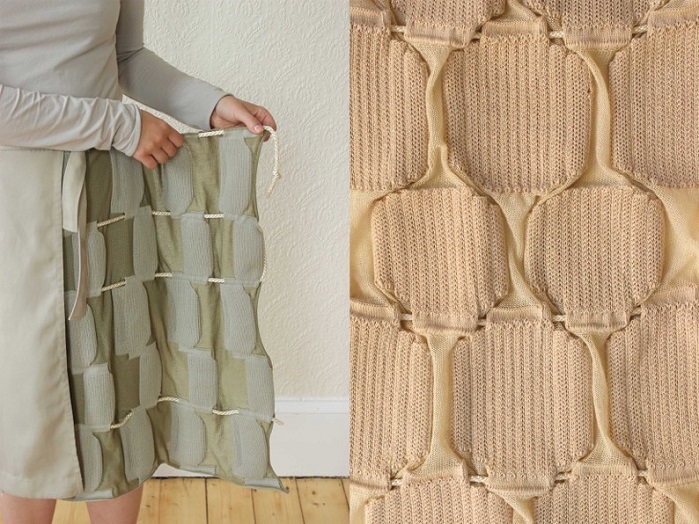
Kasey Hatch: Nottingham Trent University, MA Textile Design Innovation
OSTEO.FIT is the collection from designer Kasey Hatch, described by Kasey as ‘a sportswear collection that encourages women with osteoporosis to engage with physical activity, whilst wearing products to treat the condition.’
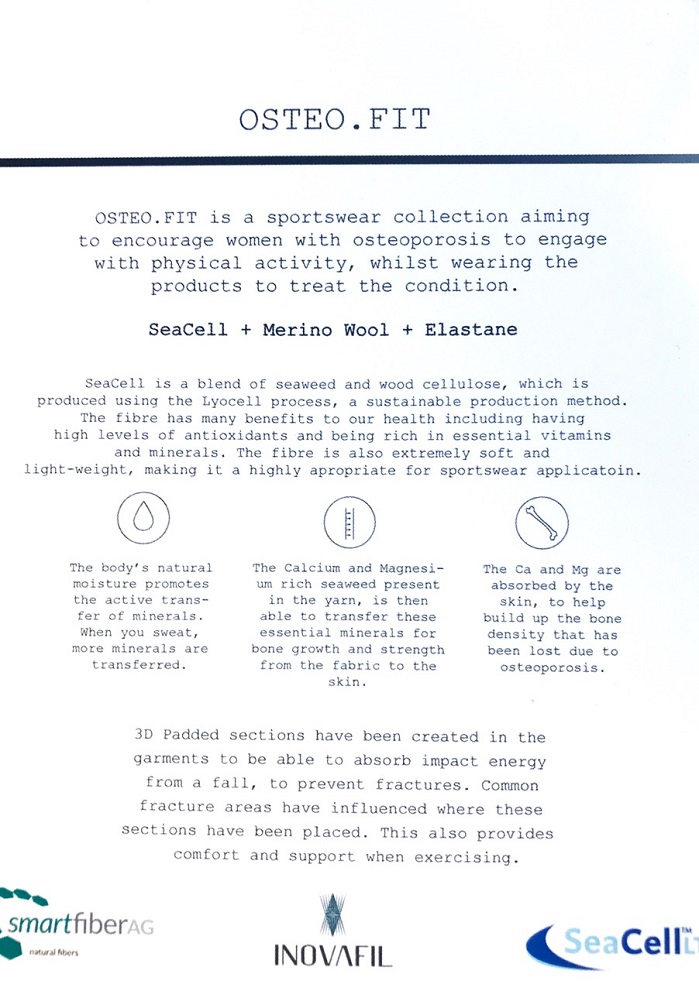
Exploring the use of SeaCell within her collection, Kasey realised the potential health benefits of the fibre, containing antioxidants, calcium and magnesium which can be transferred to the body when women sweat. 3D padded sections incorporated into her designs create areas of cushioning to absorb impact upon falls. Kasey has considered the ‘ingredients’ of her material developments as much as the structural elements to create a collection that could be the beginning of a new found sense of confidence in sufferers of osteoporosis.
Sponsored by Smartfiber AG and Inovafil, Kasey’s work was produced on the ADF 32W multi-gauge Stoll machine, in gauges 12 and 14.
This collection stood out because of its empowering approach to technical fabric development. Kasey’s collection tackled material problems whilst confronting social issues. It is admirable to see a new generation of designers who are acknowledging areas that require attention in material development as well as social inclusivity and challenge themselves to pave the way for future solutions.
Hoping to get a job within sportswear design or materials development Kasey plans to embark on a PHD in a few years time after gaining more industry experience.
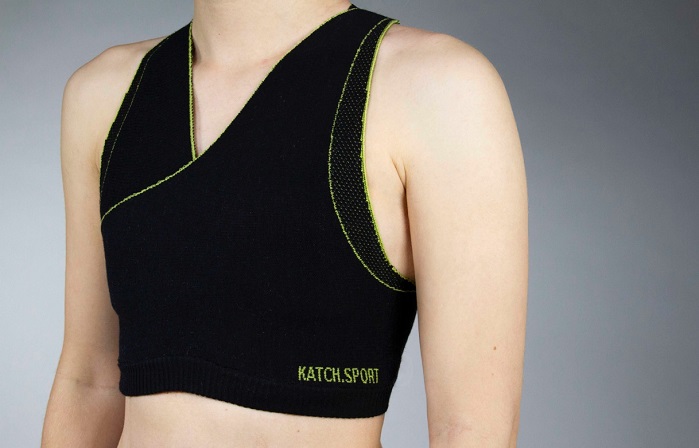
Adrianne Shirlow: Belfast School of Art
Adrianne presented her womenswear collection, which she created using British Wool and Lyocell. With a focus on sustainable processes, she employed closed loop manufacturing methods to utilise each and every step in her creation process. Creating a stand out knitwear collection is a challenge in itself, but to achieve this with the extra self-imposed challenges of meeting responsible creation standards is particularly impressive. Hand dyeing all her yarns to maintain control over water wastage and chemical contamination, Adrianne uses the waste-water as paint to create inspiring art work. This attention to detail creates a narrative that supports her colourful collection.
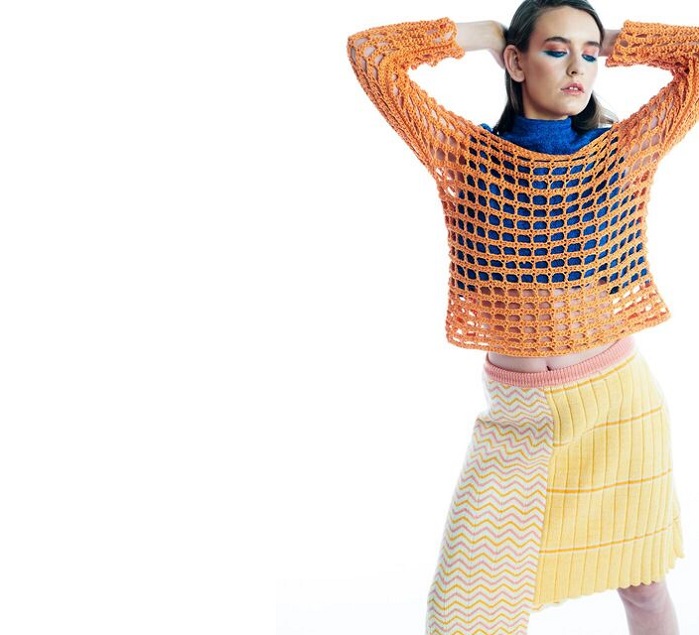
Faye Fraser: Nottingham Trent University, MA Textile Design Innovation
Faye’s collection Kompost is a reaction to the issue of micro plastic fibre pollution. She took the opportunity within her MA to explore performance fabrics using cellulose, protein and recycled fibres. She has made a collection with a high percentage of degradability, containing chemical free finishing. Her fabrics explore techniques such as birds eye jacquard with mesh, and tubular ripple with interlock across the collection of garments.
Faye’s initial intention was to use bio-elastane (elastane derived from plant-based polymer instead of petroleum) so that any materials facilitating stretch could in theory be completely degradable. Unable to achieve sponsorship for this material, and with the cost of these new yarns often being so high in their infancy, Faye adapted to the situation and began to explore circularity within her designs. She subsequently achieved sponsorship from Asahi Kasei with their product range Roica EF, the world’s first recycled elastic polyurethane filament.
Incorporating natural dyes into her collection, Faye explained: “I faced issues with the natural dyes in terms of colour regularity and use of water. I tried to use concentrated purple corn powder instead of whole corn cobs, as I could source this in the U.K, rather than Peru, being conscious of my carbon footprint. Using the powder meant it was not as controllable as with the slower release of pigment from the whole corn cobs. This led to some problems with irregularity that meant I had to over dye some fabrics.”
Faye’s ability to adapt to achieve sustainable practice within different contexts despite the obstacles is inspiring. It is clearly a skill of Faye’s, that she assesses the environment in which she is working and tailors her practices to achieve as low a carbon footprint as possible, with the most sustainable materials she is able to attain.
Now she has graduated in her MA, Faye would like to work within the textile performance sector on sustainable innovation within knitwear.
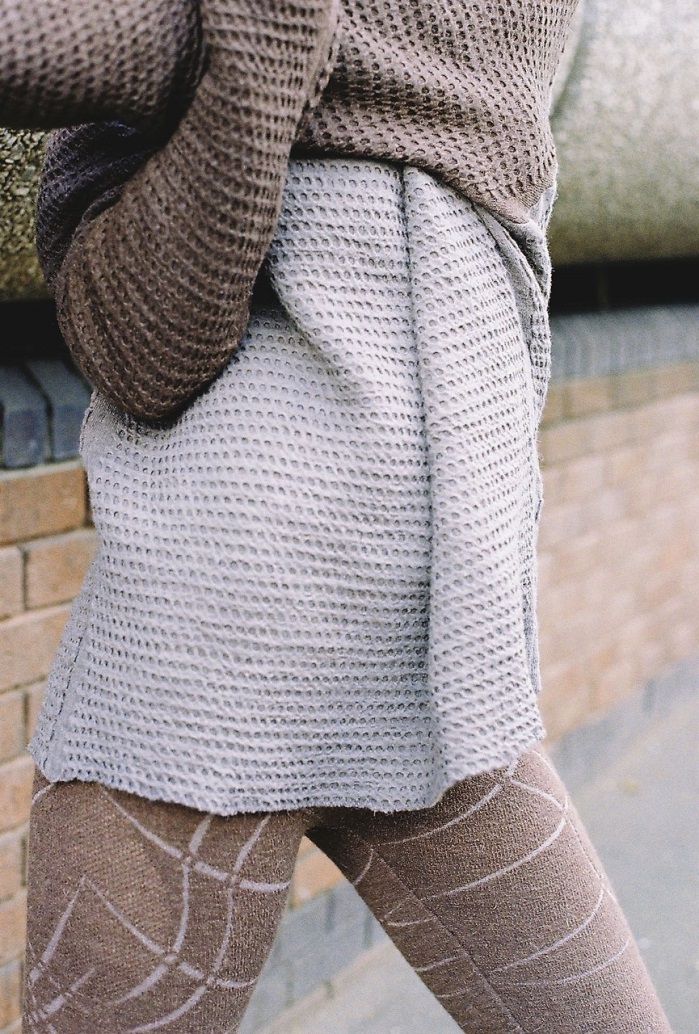
Olivia J Holland: Cockpit Arts – One Year In
Launching her latest work, The Berlin Collection at New Designer’s One Year In, Olivia showed her collection of handcrafted accessories for fashion and the home, displaying an impressive sensibility to colour and a complex understanding of stitch structures.
Graduating from Chelsea College of Art with a BA in Textile Design in 2014, Olivia won the Cockpit Arts Haberdashers Award in 2017, which granted her a free place at Cockpit Arts’ Business Incubator. Still based at her studio at Cockpit Arts in Deptford, she creates all her pieces by hand on her hand flat Industrial 12gauge knitting machine.
Handcrafted and hand finished, each piece is totally individual and promotes longevity and preservation of craft. Using a 12gauge Santagostino industrial knitting machine, often with silk and Cashwool, Olivia’s work encompasses her attention to detail and her belief that if something is cared for in its creation process, it will be cared for during its lifespan too. This approach to sustainability is a movement against fast fashion, aiming to instil a sense of value back into the textiles that consumers buy.
By championing analogue craft methods and cutting no corners in the luxury creation process, Olivia is a designer who aims to challenge preconceptions of textiles and encourage responsible purchasing habits.
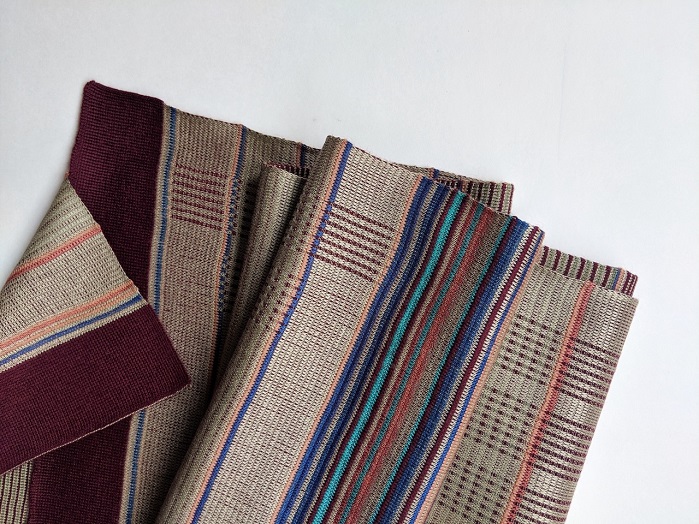
Scarlett Adams: The Royal College of Art, One Year In
Featured in one of KIC’s latest articles Landscapes of the Body, Scarlett Adams is a knitwear designer with an illustrative approach to the origins of her knitwear design. Within the One Year In exhibition at New Designers, Scarlett showcased her illustrations inspired by landscapes of the body and knitted structures. Standing with her work for the duration of the show, Scarlett was able to chat with visitors about the knitted inspiration behind her mark making and enhance perceptions of textile design by sharing her unique practice.
Creating and selling her work plastic free, and experimenting with paper made from recycled coffee cups, Scarlett is striving for a responsible practice. With no knitted pieces on display, Scarlett displayed only a pair of knitting needles. This was a subtle nod to her background of materiality and triggered talking points from an audience who found her illustrative approach to knitwear design fascinating.
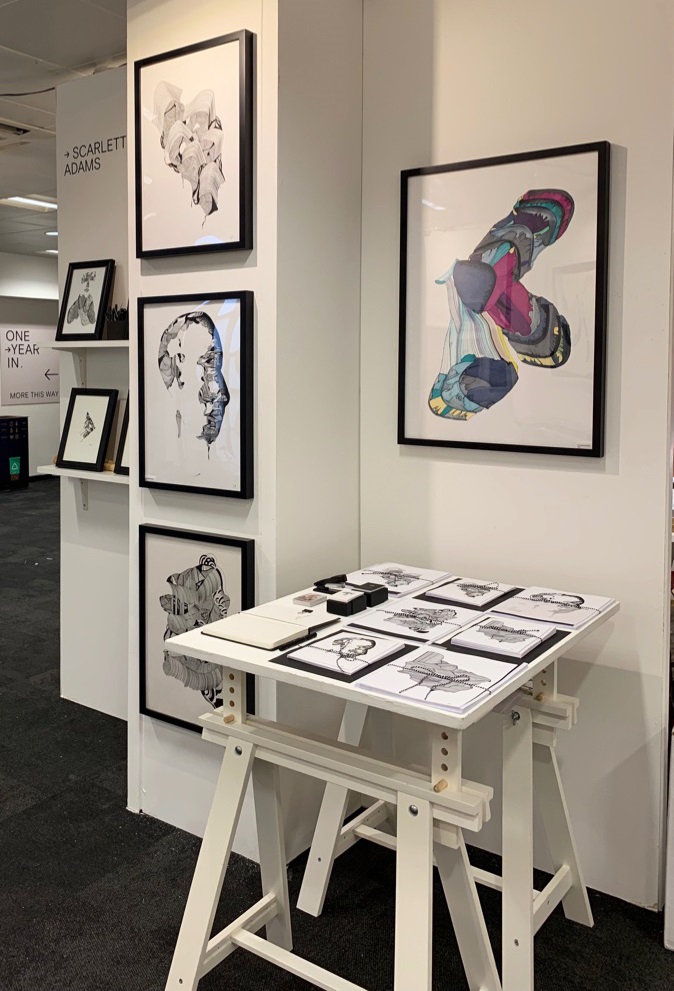
With a variety of approaches to knitted textiles and knitwear design, these seven designers represent a generation of creatives that aspire to do more that create for the sake of creativity. Their projects act as catalysts for fundamental change, whether in terms of changing manufacturing processes or changing perceptions of knitted textiles and materiality. They are certainly all ones to watch.

Subscribe To Our Newsletter
Join our mailing list to receive the latest news and updates from our team.


